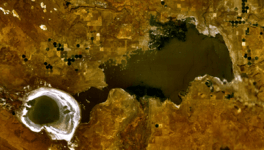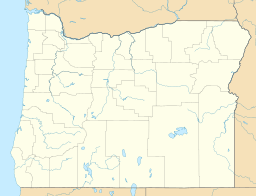Harney Lake facts for kids
Quick facts for kids Harney Lake |
|
|---|---|

Satellite image of Harney Lake (left) and Malheur Lake (right)
|
|
| Location | Harney County, Oregon, United States |
| Coordinates | 43°14′13″N 119°06′32″W / 43.23694°N 119.10889°W |
| Type | alkali lake |
| Catchment area | 5,125 sq mi (13,270 km2) |
| Basin countries | United States |
| Surface area | 26,400 acres (10,700 ha) |
| Shore length1 | 28 mi (45 km) |
| Surface elevation | 4,084 ft (1,245 m) |
| 1 Shore length is not a well-defined measure. | |
Harney Lake is a shallow, salty lake in southeast Oregon, United States. It is about 30 miles (48 km) south of the city of Burns. This lake is inside the Malheur National Wildlife Refuge. It is also the lowest point in the Blitzen Valley drainage area.
Contents
History of Harney Lake
Harney Lake has had a few different names over time. In 1838, it was called Salt Lake. Other names included Tonowama and Lake Harney.
For about 9,000 years, the Northern Paiute Indians lived around Harney Lake. They mostly used the area as winter camps. Today, you won't find many modern homes near the lake. The closest town is Narrows.
How Water Levels Change
During years with a lot of rain, Harney Lake gets water from Malheur Lake. Malheur Lake is about 10 miles (16 km) to the east.
Harney Lake is very shallow. In normal years, it is less than 4 feet (1.2 m) deep. Sometimes, during dry periods, the lake can dry up completely.
Life in the Lake
Because Harney Lake is a salty (alkali) lake, not many living things can survive in its waters. The only animal found in Harney Lake is a type of inland brine shrimp.
Even with little food, the lake is very important for birds. It is part of a large marsh system that helps many migratory birds in the dry desert of southeast Oregon.
Ecology and Wildlife
Redband Trout in the Malheur Lake Basin
The Great Basin redband trout used to be able to reach Malheur and Harney lakes. However, human activities have made it harder for them. These activities include irrigation, changing river paths, and draining marshlands. Also, the high saltiness of Harney Lake makes it impossible for trout to live there. Today, redband trout in the Malheur Lakes Basin live in smaller and medium-sized streams.
The redband trout is a special type of fish. It has adapted to the unique environment of the Malheur Lake Basin. In these closed desert basins, redband trout have learned to survive in places with big changes in water flow and temperature. They are one of only eight groups of native redband trout living in inland desert basins.
There are 10 different groups of Malheur Lakes redband trout. Historically, all the streams were connected. This allowed these fish to move between the lakes and different groups.
Protecting the Redband Trout
The Redband Trout is not officially listed as an endangered species. However, people know it is an important animal. The Steens Mountains Cooperative Management and Protection Act of 2000 is a law that helps protect these fish. This law sets aside land in Oregon for the protection and study of Redband Trout.



